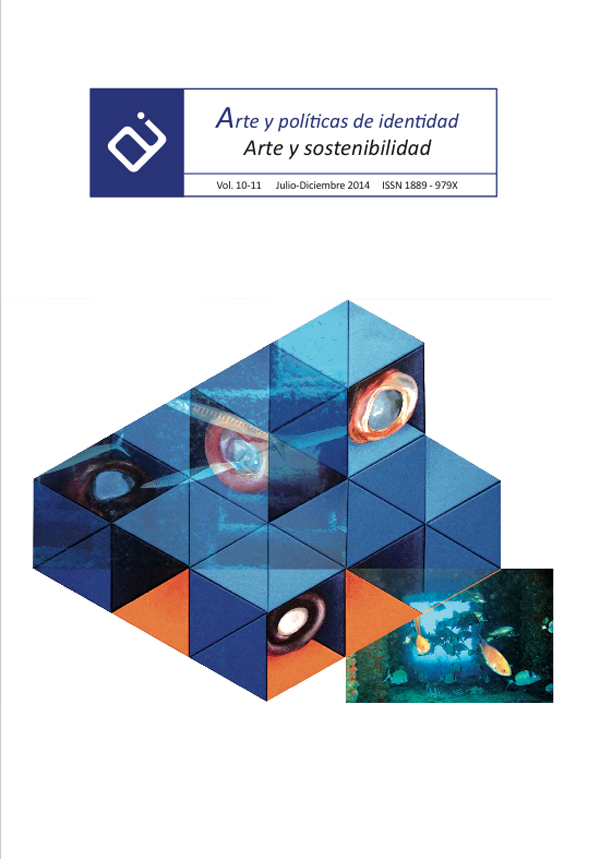Bioart: Between Technological Dazzle and Critical Look
Abstract
The article analyses the works and arguments of artists belonging to bioart and transgenic art, among them Eduardo Kac, Critical Art Ensemble, Natalie Jeremijenko. In addition, it examines the contributions of theorists such as Sergio Roncallo, Jorge Riechmann and Carol Gigliotti. It takes a stand in the ethical debate about bioart, in order to investigate the implications of the art performed by means of biotechnologies from the ecological ethics point of view. In some cases it is possible to detect an aprioristic faith in the new technologies and the use of public debate as an instrument, in other cases the artworks claim to be based on ecological concerns, not always with convincing results.Downloads
-
Abstract896
-
PDF (Español (España))2175
References
Albelda, J. (2003). Territorios, caminos y senderos. En J.B. Peiró (Coords.) (2ª ed.) Otras naturalezas (pp. 23-30). Mucia: Comunidad Autónoma.
----- (2004) Fabrikart, 4, 100-113.
Albelda, J. y Saborit, J. (1997). La construcción de la naturaleza. Valencia: Generalitat Valenciana.
Biografía. Eduardo Kac, (n.d). Recuperado el 25 de marzo de 2014 de http://www.ekac.org/kac4.html
Bolognini, M. (2004); Bioestetica, arte transgenica e il coniglio verde. Conversazione con Eduardo Kac. Luxflux proto-type arte contemporanea 11. Recuperdado el 27 de marzo de 2014 de http://www.ekac.org/luxflux2005.html
-----(2005). Dimenticare l’arte. Conversazione con Mario Costa. Luxflux proto-type arte contemporanea,12.Recuperdado el 27 de abril de 2014 de http://luxflux.net/dimenticare-l%E2%80%99arte-conversazione-con-mrio-costa/
De Vicente, J. L. (2001). Eduardo Kac. Artísta electronico. El creador de seres imposibles. El Mundo, Madrid. Recuperdado el 27 de abril de http://www.elmundo.es/navegante/2001/09/10/entrevistas/1000132841.html
Dixon, D. P. (2009). Creating the semi-living: on politics, aesthetics and the more-than-human. Transactions, 34(4), 411-425.
Dobrila, P. T. y Kostic, A. (Eds.). (2000). Eduardo Kac: Telepresence, Biotelematics, Transgenic Art. Maribor (Slovenia): KIBLA.
Duque, F. (2008). Habitar la tierra. Medio ambiente, humanismo, ciudad. Madrid: Adaba.
Durán A. y Riechmann J. (Coords.). (1998). Genes en el laboratorio y en la fábrica. Madrid: Trotta.
Giannetti, C. (1997). Metaformance - El sujeto – proyecto. En Luces, cámara, acción (...)¡Corten! videoacción: el cuerpo y sus fronteras, 91-102. Valencia: IVAM, Centre Julio González. Recuperdado el 25 de abril de 2014 de http://www.artmetamedia.net/pdf/Giannetti_Metaformance.pdf
Gigliotti, C. (2006). The ethics of artists working with genetic technologies En C. Gigliotti (Ed.), Leonardo’s choice (pp. 61-74). London: Springer-Verlag.
Jonas, H. (1995). El principio de responsabilidad: ensayos de una ética para la civilización tecnológica. Barcelona: Herder Editorial.
López del Rincón, D. (2010). Nuevos modos de concebir el cuerpo y la identidad: la biónica y la biotecnología como nuevas herramientas de creación artística. Actas de IV Jornadas Internacionales Universos y metaversos: aplicaciones artísticas de los nuevos medios. 7 y 14 de abril de 2010. (pp. 75-84). Facultad de Geografía e Historia de la Universidad de Barcelona., 75-84. Recuperdado de el 25 de abril de 2014 de http://www.artyarqdigital.com/fileadmin/user_upload/PDF/Publicaciones_jornadas_IV/publicacion_ub_sin_marcas_portada.pdf
----- (2012). Bioarte y entorno: de la artificialización de la naturaleza al artivismo biotecnológico. Actas del III Congreso Internacional de Arte y Entorno. 16-18 noviembre 2011. (pp. 267-277). Universidad Politécnica de Valencia.
Quaranta, D. (2010). La prospettiva postmediale. En Media, New Media, Postmedia (trad. C. Penella de Silva) (pp.139-167). Milano: Postmediabooks. Recuperado el 24 de abril de 2014 dehttp://www.tintank.es/?p=1196. Versión inglesahttp://editions.linkartcenter.eu/
Riechmann, J. (1997). La industria de las manos y la nueva naturaleza. Sobre naturaleza y artificio en la era de la crisis ecológica global.Ecología Política, 13, 87-106.
----- (2006). Biomímesis. Madrid: Los libros de la Catarata.
----- (2011). ¿Cómo vivir?, acerca de la vida buena. Madrid: Los libros de la Catarata.Roncallo, S. (2008). El Arte Transgénico: debates y perspectivas (una lectura ético-política). El artista: revista de investigaciones en música y artes plásticas, 5, 75-95.
Schwartz, J. (2008). Museum Kills Live Exhibit. The New York Times.Recuperado el 25 de abril de 2014 de http://www.nytimes.com/2008/05/13/science/13coat.htmlShiva, V. (2001). Biopiratería: el saqueo de la naturaleza y el conocimiento. Barcelona: Icaria.
Singer, P. (2011). Liberación animal. Madrid: Taurus (última edición en castellano).
Sitio web del artista Brandon Ballengée (n.d.). Recuperado el 27 de marzo de 2914 de http://brandonballengee.com/
Sitio web del artista Eduardo Kac (n.d.). Recuperado el 27 de marzo de 2014 de http://www.ekac.org/nat.hist.enig.sp.html
Sitio web del colectivo Tissue Culture & Art Project (n.d.). Recuperado el 26 de marzo de 2014 de http://tcaproject.org/
Zurr, I.y Catts, O. (2003). The ethical claims of bioart: killing the other or self-cannibalism? Australiam and New Zeland Journal of Art, Art Ethics, 4, 167–188. Recuperado el 25 de abril de 2014 de http://www.tca.uwa.edu.au/publication/TheEthicalClaimsofBioart.pdf
----- (n.d.). Victimless Leather:A Prototype of Stitch-less Jacket grown in a Technoscientific ‘Body’. En The tissue culture and Art project. Recuperado el 25 de abril de 2014 de http://www.tca.uwa.edu.au/vl/vl.html
Zylinska, J. (2009). Bioethics in the Age of New Media. Cambridge: MIT Press.
Works published in this journal are subject to the following terms:
- The Service of Publications from the University of Murcia (publishing house) keeps the published works’ copyrights, and favors and allows the reuse of these works under the license indicated in point 2.
- Works are published in the journal’s online edition under the license Creative Commons Reconocimiento-NoComercial-SinObraDerivada 3.0 España(texto legal). They can be copied, used, disseminated, transmitted and publicly exhibited, as long as: i) the author and original source of publication are cited (journal, publishing house and work’s URL); ii) they are not used for commercial purposes; iii) the existence and specifications of this license are mentioned.
3. Conditions for auto-file. It is allowed and encouraged that authors share electronically their pre-print version (the pre-reviewed version) and /or post-print version (the reviewed and accepted version) of their Works before the publication, since it promotes its circulation and dissemination. RoMEO color: green.










